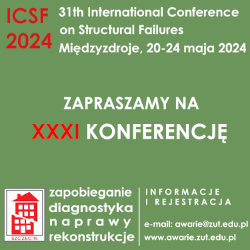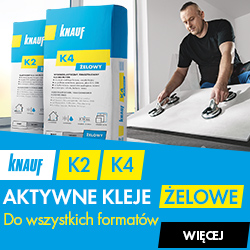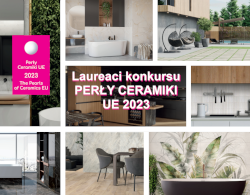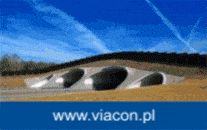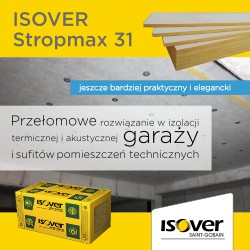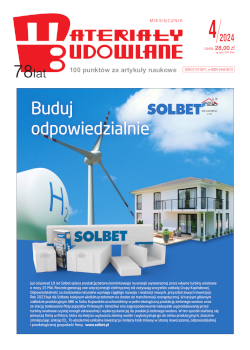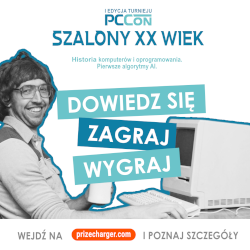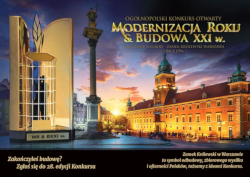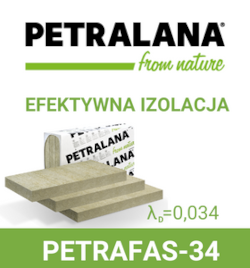Open Access (Artykuł w pliku PDF)
Ultralight foamed concrete with the addition of phase change material for thermal insulation applications
prof. dr hab. inż. Barbara Klemczak, Politechnika Śląska (SUT), Wydział Budownictwa, Poland
ORCID: 0000-0002-8102-894X
prof. dr inż. Edwardus A. B. Koenders, Technical University of Darmstadt (TUDa), Institute of Construction and Building Materials, Germany
ORCID: 0000-0001-8664-2554
prof. dr inż. Henk Jonkers, DelftUniversity of Technology (TUD), Netherlands
ORCID: 0000-0003-1156-7195
prof. dr inż. Victor Fachinotti, Centro de Investigación de Métodos Computacionales (CIMEC), Argentina
ORCID: 0000-0002-5702-6274
dr inż. Christoph Mankel, Technical University of Darmstadt (TUDa), Institute of Construction and Building Materials, Germany
ORCID: 0000-0001-8376-6156
dr inż. Frank Röser, Wilhelm Roser Sohne GMBH CO. KG (RIB), Germany
ORCID: 0000-0002-5926-1593
dr Jorge S. Dolado, Materials Physics Centre (MPC), Spain
ORCID: 0000-0003-3686-1438
dr Edurne Erkizia, TECNALIA, Basque Research and Technology Alliance (BRTA), Spain
ORCID: 0000-0003-4343-7141
dr Jean-Luc Dauvergne, Centre for Cooperative Research on Alternative Energies (CICenergiGUNE), Spain
ORCID: 0000-0002-5356-5596
dr Amaya Ortega, GRAPHENEA SA, Spain
ORCID: 0000-0002-2285-5988
dr Francesca Zanoni, SPHERA ENCAPSULATION SRL, Italy
dr inż. Jan Červenka, Červenka Consulting, Czech Republic
ORCID: 0000-0003-4945-1163
mgr inż. Michael Düngfelder, NETZSCH Geratebau GMBH, Germany
mgr Christina Stunz, NETZSCH Geratebau GMBH, Germany
mgr Dmitry Zhilyaev, Delft University of Technology (TUD), Netherlands
ORCID: 0000-0003-1277-8891
mgr inż. arch. Vesselin A. Kolev, Glavbolgarstroy Holding AD (GBS), Bulgaria
Adres do korespondencji: Ten adres pocztowy jest chroniony przed spamowaniem. Aby go zobaczyć, konieczne jest włączenie w przeglądarce obsługi JavaScript.
DOI: 10.15199/33.2024.02.09
Oryginalny artykuł naukowy
Streszczenie. W artykule przedstawiono wybrane wyniki projektu NRG-STORAGE, którego celem jest opracowanie ultralekkiego pianobetonu z dodatkiem materiału zmiennofazowego (PCM), który ma zdolność do magazynowania i uwalniania ciepła. Uzyskane wyniki pokazały, że badany pianobeton o gęstości objętościowej 240 kg/m3 z dodatkiem 10% PCM charakteryzuje się wystarczającą wytrzymałością mechaniczną jako materiał termoizolacyjny, dobrymi właściwościami termofizycznymi oraz zdolnością do akumulacji i oddawania ciepła.
Słowa kluczowe: pianobeton; materiał zmiennofazowy (PCM); wytrzymałość na ściskanie; właściwości cieplne; skurcz.
Abstract. The article presents selected results of the NRG- -STORAGE project, aiming to develop ultralight foamed concrete with the addition of phase change material (PCM), which has the ability to store and release heat. The obtained results showed that the tested foamed concrete with a bulk density of 240 kg/m3 and with the addition of 10% PCM is characterised by sufficient mechanical strength for thermal insulation applications, good thermophysical properties, and the ability to accumulate and release heat.
Keywords: foamed concrete; phase change material (PCM); compressive strength; thermal properties; shrinkage.
Literatura
[1] European Council: Fit for 55 package; https://www. consilium. uropa. eu/en/policies/green-deal/fit-for-55-the-eu-plan-for-a-green-transition/.
[2] Dean B, Dulac J, Petrichenko K, Graham P. Towards Zero-Emission Efficient and Resilient Buildings. Global Status Report (GABC), 2016.
[3] European Commission. Energy Use in Buildings; https://ec. europa. eu/energy/ eu-buildingsfactsheets- topics-tree/energy-use-buildings_en.
[4] European Commission; https://energy.ec.europa.eu/topics/energy-efficiency/ heating-and-cooling_en.
[5] Kadela M, Winkler-Skalna A, Łoboda B, Kukiełka A. Pianobeton – charakterystyka materiałowa oraz możliwości zastosowania. Materiały Budowlane. 2015; DOI: 10.15199/33.2015.07.30.
[6] Kadela M, Kukiełka A, Winkler-Skalna A. Ocena nasiąkliwości i mrozoodporności pianobetonu. Materiały Budowlane. 2016; DOI 10.15199/33.2016.10.16.
[7] Fu Y, Wang X,Wang L, LiY. Foam Concrete: A State-of-the-Art and State-of-the- -PracticeReview. Adv. Mater. Sci. Eng. 2020; https://doi. org/10.1155/2020/6153602.
[8] Amran YHM, Farzadnia N, Abang Ali AA. Properties and applications of foamed concrete; a review. Constr Build Mater. 2015; https://doi. org/10.1016/j. conbuildmat. 2015.10.112.
[9] Gołaszewski J, Klemczak B, Smolana A, Gołaszewska M, Cygan G, Mankel C, Peralta I, Röser F, Koenders EAB. Effect of Foaming Agent, Binder and Density on the Compressive Strength and Thermal Conductivity of Ultra-Light FoamConcrete, Buildings. 2022; https://doi.org/10.3390/buildings12081176.
[10] Gołaszewski J, Klemczak B, Smolana A, Gołaszewska M, Cygan G, Mankel C, Peralta I, Röser F, Koenders E. Wpływ rodzaju środka pianotwórczego na właściwości pianobetonu o bardzo małej gęstości. Materiały Budowlane. 2022; DOI: 10.15199/33.2022.07.08.
[11] Pizoń J. Fresh, Mechanical, and Thermal Properties of Cement Composites Containing Recycled Foam Concrete as Partial Replacement of Cement and Fine Aggregate. Mater. 2023; https://doi. org/10.3390/ma16227169
[12] Fachinotti VD, Bre F, Mankel C, Koenders E, Caggiano A. Optimization of Multilayered Walls for Building Envelopes Including PCM-Based Composites. Mater. 2020; https://doi. org/10.3390/ma13122787.
[13] Zhilyaev D, Fachinotti VD, Zanoni F, OrtegaA, GoracciA, Mankel C, Koenders E, Jonkers HM. Early-stage analysis of a novel insulation material based on MPCM-doped cementitious foam: Modelling of properties, identification of production process hotspots and exploration of performance trade-offs. Dev. Built Environ. 2023; https://doi.org/10.1016/j.dibe. 2023.100243.
[14] NRG – STORAGE. Integrated Porous Cementitious Nanocomposites In Non-Residential Building Envelopes For Green Active/Passive Energy Storage, https://nrg-storage. eu/.
[15] Sam M, Caggiano A, Dubyey L, Dauvergne JL, Koenders E. Thermo-physical andmechanical investigation of cementitious composites enhanced with microencapsulated phase change materials for thermal energy storage. Constr Build Mater. 2022; https://doi.org/10.1016/j.conbuildmat. 2022.127585.
[16] Erkizia E, Strunz C, Dauvergne JL, Goracci G, Peralta I, SerranoA, OrtegaA, Alonso B, Zanoni F, DüngfelderM, Dolado JS, Gaitero JJ,Mankel C, Koenders E. Cement BasedMaterials with PCMand Reduced Graphene Oxide for Thermal Insulation for Buildings. Intern. RILEMConf. SYNERCRETE, Springer Nature Switzerland, Cham, 2023, s. 1264–1276.
[17] Klemczak B, Gołaszewski J, Cygan G, Smolana A, Gołaszewska M Analysis of Methods Reducing Early Age Shrinkage of Ultra-light Foam Concrete with Phase Change Material. Intern. RILEM Conf. SYNERCRETE, Springer Nature Switzerland, Cham, 2023, s. 1143–1152.
[18] Červenka J, Herzfeldt M, CaggianoA, Koenders E. Evaluation of thermal and mechanical properties of demonstrationwall utilizing phase change cementitiousmaterials. Ac. Polyt. CTU Proc. 2022; https://doi.org/10.14311/APP. 2022.38.0502.
[19]Microtek Laboratories, inc. https://www.microteklabs.com/product-data-sheets/.
[20] Applied Precision Ltd, ISOMET 2114 Thermal properties analyser User’s Guide, Bratislava, SLOVAKIA, 2011.
[21] NETZSCH Geratebau GMBH. https://analyzing-testing. netzsch. com/pl/produkty/thermal-conductivity.
[22] Schleibinger Geräte. Schleibinger Shrinkage-Drain. 2017.
[23] Nambiar E, Ramamurthy K. Shrinkage Behavior of Foam Concrete. J Mater Civ Eng. 2009; https://doi.org/10.1061/(ASCE) 0899-1561 (2009) 21: 11 (631).
[24] Zhao W, Su Q, Wang W, Niu L, Liu T. Experimental Study on the Effect of Water on the Properties of Cast In Situ Foamed Concrete. Adv. in Mat. Sc. Eng. 2018; https://doi. org/10.1155/2018/7130465.
Przyjęto do druku: 29.01.2024 r.
Materiały Budowlane 2/2024, strona 45-49 (spis treści >>)










